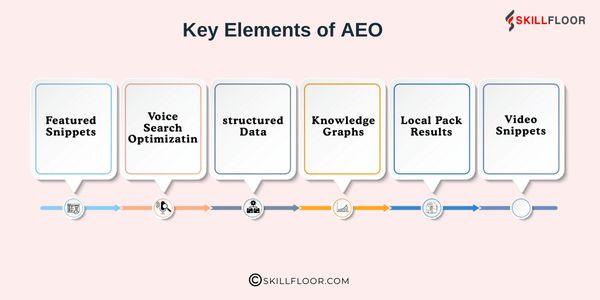What is Answer Engine Optimization?
Struggling to rank in voice search? Learn AEO strategies to appear in featured snippets, and answer boxes, and drive more traffic to your site now.

Answer Engine Optimization (AEO) is a subset of search engine optimization (SEO) focused on optimizing content so that it’s featured by virtual assistants, answer boxes, and featured snippets in search engines. While AEO shares many characteristics of traditional SEO, it focuses more on answering specific questions directly and concisely.
If you use voice assistants like Alexa, Siri, or Google Assistant, you’re already familiar with how our search behavior is shifting. Instead of typing short keywords, people are asking full, conversational questions.
This is where AEO comes in. It helps businesses ensure that customers can easily find information about their products, services, or business when using these voice-activated devices.
So, what exactly is Answer Engine Optimization, and how can it help your business? Let’s dive in!
Introduction to AEO
Answer Engine Optimization (AEO) is a strategy to make your content show up as a direct answer to people’s questions when they search on Google or other search engines. In simple terms, instead of just making your website show up in search results, AEO helps you get your content featured as a quick answer right at the top of the search page.
When you search for something on Google, sometimes you get an answer right away, like a definition or a brief explanation, without even clicking a link. That’s AEO at work. Instead of just showing links to websites, search engines are providing answers directly on the search results page. This is especially important as more people use voice search with devices like smartphones and smart speakers (Siri, Alexa, Google Assistant).
Why AEO Matters
Before diving into how AEO works and how to optimize for it, it’s essential to understand why it’s become such a crucial part of digital marketing.
1. The Growth of Voice Search
One of the primary reasons AEO has gained so much traction is the increasing popularity of voice search. With more people using smart devices and digital assistants like Google Assistant, Siri, and Alexa, voice search has become a dominant method for interacting with search engines. When people use voice search, they tend to ask questions more naturally, as if they’re speaking to a person.
For example, instead of typing “weather forecast,” they might say, “What’s the weather like today?” This shift in search behaviour makes it crucial for content to be optimized in a way that answers these questions clearly and concisely.
2. Direct Answers on the Search Engine Results Page (SERP)
Search engines are evolving to provide answers directly on the SERP instead of just providing links to other websites. We’ve all seen it: you type a question into Google, and before you even get to the search results, you get a concise, direct answer at the top of the page. This feature, known as Featured Snippets, is designed to provide users with the information they’re seeking without the need to click on a link.
These direct answers are typically pulled from high-quality content, and this is where AEO comes in. If you can optimize your content to answer these queries effectively, there’s a good chance your site could appear in a Featured Snippet, Knowledge Panel, or another answer-focused feature.
3. Enhanced User Experience
AEO directly ties into the growing trend of prioritizing user experience. People want their questions answered as quickly as possible, and search engines are more than happy to comply. By providing answers directly in the search results, search engines help users find the information they need without unnecessary clicks. This trend not only improves user satisfaction but also reflects how the digital environment is shifting toward a more efficient, user-centric approach.
Key Elements of AEO
So, what exactly does AEO involve? There are several key elements that make up the process of optimizing your content for answer engines.
1. Featured Snippets
One of the most well-known aspects of AEO is Featured Snippets. These are the boxed answers that appear at the top of search results, usually highlighted with a “snippet” of the most relevant content pulled directly from a website. There are several types of Featured Snippets:
-
Paragraph Snippets: These provide a brief, direct answer in paragraph form. For example, “What is Answer Engine Optimization?” might show a direct definition as a paragraph snippet.
-
List Snippets: These display information in a bulleted or numbered list. This type is often used for how-to guides or steps.
-
Table Snippets: These are great for comparison queries and show data in a table format.
The goal of AEO is to optimize your content so that it’s eligible to appear in one of these snippet formats.
2. Voice Search Optimization
Since voice search is conversational, optimizing your content for voice queries is a critical aspect of AEO. People tend to ask longer, more natural-sounding questions when speaking to voice assistants. For example, instead of searching for “best smartphone 2025,” they might ask, “What’s the best smartphone to buy in 2025?”
The key here is to structure your content to reflect the way people speak and ask questions. Using long-tail keywords and crafting responses in a natural tone increases the chances of your content being picked up by voice search devices.
3. Structured Data (Schema Markup)
If you’ve ever heard of schema markup, then you know that it’s a form of structured data that helps search engines better understand the context of your content. By implementing schema markup, you can provide search engines with detailed information about your content (like products, reviews, events, and FAQs).
Schema markup plays a crucial role in AEO because it helps search engines interpret your content and display it as a direct answer in knowledge graphs, rich snippets, or other answer-driven results.
4. Knowledge Graphs
Another important element of AEO is the Knowledge Graph, a feature that provides information in a box on the right-hand side of the search results page. The Knowledge Graph often pulls answers from trusted sources and can include facts, figures, and other relevant information. Optimizing your content for inclusion in the Knowledge Graph requires authoritative, high-quality content and structured data.
5. Local Pack Results
Local pack results appear when people search for things near them, like "restaurants near me" or "plumbers in [city]." These results show a map and a list of local businesses that match the search.
If you have a business that serves a specific location, make sure your Google My Business profile is set up correctly to increase your chances of showing up in these local search results.
6. Video Snippets
Video snippets are search results that show video content when it’s relevant to the search query. For example, if you search for “how to bake a cake,” you might see a video snippet showing a video that explains how to do it.
If you create videos, make sure your titles, descriptions, and tags are clear and relevant to the topic, so search engines can pick them up for video snippets.

How AEO Works
The process behind AEO involves several steps that aim to help search engines deliver answers from your content. Let me walk you through the basics.
1. Identifying Relevant Questions
The first step in AEO is identifying the questions your audience is asking. By researching common queries in your niche, you can understand what people are looking for and tailor your content accordingly.
You can use tools like Google’s People Also Ask, Answer the Public, or keyword research tools like Ahrefs and SEMrush to uncover these questions.
2. Structuring Content for Answers
Once you know the questions, the next step is structuring your content to provide clear, concise answers. The answer should come at the beginning of your content (usually within the first 100-200 words) and be as direct as possible. Afterward, you can provide more detailed explanations or supporting information.
3. Implementing Structured Data
To increase your chances of being featured as an answer, consider adding schema markup to your content. This helps search engines better understand the structure and context of your answers, which can improve your chances of being displayed as a rich snippet or in a knowledge panel.
How to Optimize for AEO
Now that we know the key elements of AEO, let’s talk about how to actually optimize for it. There are several practical strategies you can implement to ensure that your content is primed for answer-driven results.
1. Answer User Questions Directly
When you create content, make sure you answer the question as directly and concisely as possible. This is especially important for queries that have specific answers. For example, if someone asks, “What is AEO?” make sure you provide a clear, straightforward answer at the very beginning of the page.
2. Use Lists and Bullet Points
If your content lends itself to a list format (like steps, comparisons, or tips), structure your content with bullet points or numbered lists. This makes it easier for search engines to pull the information and display it as a Featured Snippet.
3. Optimize for Voice Search
To optimize for voice search, focus on long-tail, conversational keywords. Think about how people phrase questions when speaking, and make sure your content answers those questions in a natural, spoken tone.
4. Implement Structured Data
Make use of schema markup to help search engines better understand your content. Adding schema for things like FAQs, reviews, and products can help your content appear in rich snippets or knowledge panels.
5. Update and Refresh Content Regularly
Search engines favor fresh, up-to-date content. Regularly update your posts with the latest information to keep them relevant and authoritative.
Answer Engine Optimization (AEO) is all about making your content show up as a direct answer to people’s questions in search engines. With the rise of voice search and the demand for quick, accurate information, optimizing your content for AEO is becoming more important than ever.
By answering questions, using lists, optimizing for voice search, and using structured data, you can improve your chances of getting your content featured as a direct answer in search results. This not only helps your website get more visibility but also improves the user experience by providing fast, helpful information.
Now that you understand SEO and how to optimize for it, start applying these tips to your content. With the right approach, your content could be the next answer that shows up in Google’s search results!































































